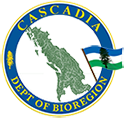Watershed, Ecoregion, Bioregion – What’s the Deal?
The Cascadia Bioregion includes major rivers such as the:
- Clearwater, Eel, Rogue, Deschutes, Bulkley, and Bella Coola.
- Columbia, Fraser, Skeena, Snake, Stikine,
- Flathead, Salmon, Nechako, Klinaklini,
- Klamath, Skagit, Lillooet-Harrison, Clearwater,
- Shohomish, Homathko, Iskut, Cowlitz, Taku,
- Squamish, Quesnel, Santiam, Umpqua, Spokane,
- Willamette, Alsek, Kootenay, Nass, Thompson, and Pend Oreille.
Internal Boundaries
Stretching for more than 2500 miles along the Pacific Coast, the Cascadia bioregion is comprised of 75 distinct ecoregions that spread across an incredible diversity and range of habitats, wilderness and landscapes. These watersheds stretch from South East Alaska to Northern California, and from the crest of the continental divide to the Pacific coast westward. Colloquially, Cascadia is more simply known as ‘Salmon Nation’, and its borders extend as far as salmon swim.
The area’s biomes and ecoregions are distinct from surrounding areas. The resource-rich Salish Sea (or Georgia Basin) is shared between British Columbia and Washington, and the Pacific temperate rain forests, comprising the world’s largest temperate rain forest zone, stretch along the coast from Alaska to California.
Watersheds, like Cascadia, transcend arbitrary borders, and are critical in understanding where our water comes from, and where it goes, as well as engaging with all of the communities affected by that discussion. Creating these holistic cultural, economic, ecological and democratic systems are why ideas like Cascadia are so important.
Cascadia is a land of falling waters, and takes its definition from the the Fraser, Columbia and Snake, flowing from the continental divide and their homes stemming from Glacier and Banff, and the former crater of the Yellowstone super volcano westward to the Pacific Ocean. The Columbia River watershed alone, the largest in Cascadia, includes parts of six US states and one Canadian province. Its border is traced, “not by governments or treaties, but by every drop of liquid that finds a common path to the ocean”.
A Watershed is simply the area created from where a rain drop falls, to the body of water it connects to. Ecoregions are comprised of these watersheds, and are used to make up the areas of a bioregion. Ecoregions are similarly defined, but are expanded to include, physical, biological, and human realities that may stem from these areas.
Each layer of information is brought together to represent the regional system. No one single factor (e.g. climate) explains everything. From these layers, we can gather a better understanding of our place, and a better framework for decision making and interaction with other areas. To understand the entire region, we must comprehend this system of relationships.
Reflecting this, federal policy planners have increasingly shifted to watershed and ecoregional planning frameworks. Government agencies at the regional, state, national and international levels are working to adopt more holistic approaches to stop dealing with single issues, or ‘point-source’ problems, to broader, regional approaches that greater take in an entire area, those most affected, and create better solutions[9].
In terms of size, an ecoregion is larger than a watershed and smaller than a bioregion; or in political terms, larger than a county and smaller than a state or province. In the more than 750,000 square miles of Cascadia, ecoregions average about 10,000 square miles each, though ranging from 2,000 to over 30,000 square miles; again, size depends upon the unique character and context of the place itself. An ecoregion in Cascadia often covers several degrees of latitude and perhaps longitude.
Since ecological systems are open and lack definite boundaries, in complex terrain, watersheds are often used to represent ecosystems on a landscape level. Here, ecoregions are often drawn as a series of contiguous watersheds with similar character and context. However, where other factors predominate–such as landforms, tectonic suites, regional rivers, vegetative breaks, or major cultural boundaries–then watershed lines may be crossed. In each case, the key is to be true to the land and its people. Boundaries are natural, and often found as soft transitional areas rather than hard-edged political lines on a map. The boundary is a convergent threshold where many layers intersect, located where several significant factors end and begin. Borders articulate the natural envelope of the place–its centers and bounds–and link this diversity into the larger world.
By starting with communities in each watershed, which will have distinct needs and shared concerns that stem from that place, and creating a dialogue that spans along an entire watershed, bioregional systems and organizing create a more systemic and holistic approach to solving many of the regions, and worlds greatest challenges.
How to Map a Bioregion:
Below are some simple steps and layers that might be useful. We recommend that you start by defining the area you want to map, find your layers, usually starting from the hard lines, working your way down through the soft, and finishing with human cultures and geography. And lastly, to find the emergences and correlations which can help guide activities, recommendations, and ways of living.



